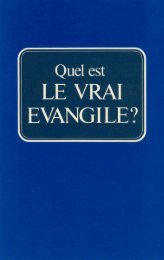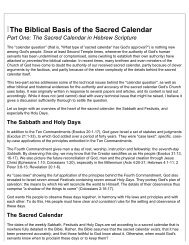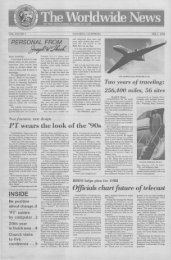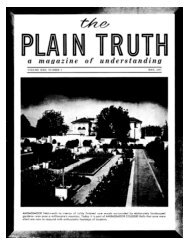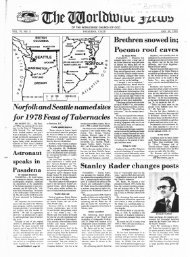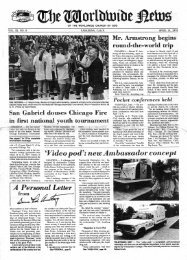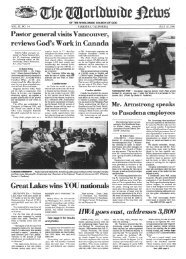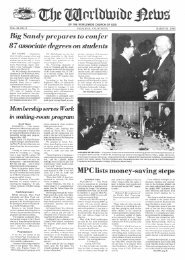PT Sep-78 - Herbert W. Armstrong Library and Archives
PT Sep-78 - Herbert W. Armstrong Library and Archives
PT Sep-78 - Herbert W. Armstrong Library and Archives
Create successful ePaper yourself
Turn your PDF publications into a flip-book with our unique Google optimized e-Paper software.
shows how urban people can do this<br />
in spite of the usual comment: 'I<br />
don't have the space, the time, <strong>and</strong><br />
the sunlight.' "<br />
When I arrived at the house, I<br />
noticed some clues to its uniqueness<br />
even before I entered. The front<br />
"lawn" in the parking strip was alfalfa<br />
rather than the usual grass. "A<br />
square meter of alfalfa produces the<br />
feed for us to grow one pound of<br />
meat per year," said Javits.<br />
The "sidewalks" were wood-chip<br />
rather than concrete. Several strategies<br />
were involved in this choice. The<br />
wood chips were a recycled community<br />
waste generated from tree clippings.<br />
Microorganisms in the soil<br />
could be nurtured by wood chips, but<br />
would be killed by concrete. Concrete<br />
would also compact the soil more<br />
than the chips. Rainwater could be<br />
absorbed by the wood chips rather<br />
than run off the property, creating<br />
storm-sewer problems, as is the case<br />
with concrete.<br />
When I entered the gate I found a<br />
young lady named Joyce Liska gathering<br />
strawberries. "We grow all of<br />
our vegetables <strong>and</strong> as much of our<br />
fruit as possible," she said. "The<br />
strawberries are delicious in<br />
spring <strong>and</strong> early summer, but the<br />
red leaves are also an attractive<br />
groundcover in the autumn.<br />
Most of the 'produce' from<br />
America's 16 million acres of<br />
lawn, the grass clippings, are<br />
thrown away, creating another<br />
waste management problem."<br />
A subtle blend of utility <strong>and</strong><br />
aesthetics controlled the choice<br />
of all the plant materials that I<br />
saw on the property. Chrysanthemums<br />
yielded an attractive<br />
flower <strong>and</strong> a green for tea.<br />
New Zeal<strong>and</strong> spinach, which is<br />
edi ble, served as a green<br />
groundcover.<br />
When I entered the front door,<br />
passing under an attractive squash<br />
vine, I picked up a Self-Guided Tour<br />
Book, which explains the house's systems<br />
in detail. Any member of the<br />
public can visit the house weekdays,<br />
using the self-guided tour, or on Saturday<br />
afternoons, when house residents<br />
offer guided tours. The informative<br />
book can also be ordered by<br />
mail for $2.S0( address noted earlier).<br />
As I looked through the description<br />
of the many individual strate-<br />
18<br />
gies used in the house <strong>and</strong> the way<br />
in which they were interrelated,<br />
they seemed to defy a celebrated<br />
mathematical axiom: The whole<br />
was greater than the sum of the<br />
parts. For example, the fish in the<br />
food-fishpond in the backyard liked<br />
to gobble up weeds tossed to them<br />
from the garden.<br />
Besides being the director of the<br />
house <strong>and</strong> an energetic young envi<br />
. ronmentalist, Tom Javits also serves<br />
as technical adviser to the City of<br />
Berkeley's innovative program to<br />
compost its tree clippings. Javits has<br />
written several informative monographs,<br />
especially in one of his areas<br />
of expertise, chicken raising in urban<br />
areas.<br />
As we talked, I looked out the<br />
window <strong>and</strong> noticed an odd-shaped<br />
screen contraption that looked like a<br />
triangular cage. What was that? "A<br />
fly trap that uses no poisons," Javits<br />
replied. "We put a plate of dog<br />
dung under the cage. Flies l<strong>and</strong> on<br />
it. Then they fly upwards to the<br />
light, as is their nature. In the screen<br />
at the bottom of the trap are several<br />
holes, which let through the most<br />
light. The flies enter the trap, then<br />
can't get out because the holes,<br />
when viewed from above, are now<br />
dark. They buzz around for a couple<br />
of days, then die, <strong>and</strong> are fed to the<br />
chickens." So even flies are a "resource"<br />
rather than a pest at the<br />
Integral Urban House !<br />
Later that morning I saw Joyce<br />
Liska feeding a garden snail to the<br />
chickens. Chickens are h<strong>and</strong>y waste<br />
aisposers, but the house residents<br />
also prize their manure as a nitrogen-rich<br />
ingredient in the compost<br />
pile.<br />
Javits left me free to w<strong>and</strong>er<br />
through the house <strong>and</strong> grounds,<br />
later returning to answer my questions.<br />
I found Suzie Sayer in the backyard<br />
on an unusual adaptation of a<br />
bicycle, called an Energy-cycle. "I'm<br />
grinding grain," she said, "using my<br />
own leg power. Besid es grinding<br />
J<br />
MORE ENERGY-SAVING FEATURES<br />
found in the Integral Urban House:<br />
1 Flow restrictor on shower-an easy<br />
way to cut freshwater consumption.<br />
2 Air convection closet in the kitchen<br />
provides natural cooling for vegetables,<br />
reducing the need for refrigeration<br />
space.<br />
3 Energy-cycle uses pedal power for<br />
such varied tasks as grinding grain,<br />
centrifuging honey, <strong>and</strong> sharpening<br />
knives.<br />
4 Boiling water for afternoon tea, solar<br />
style.<br />
S Swedish-made dry composting toilet<br />
produces dramatic savings in<br />
freshwater consumption.




